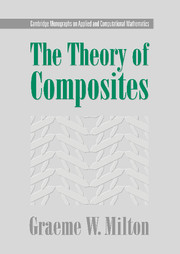Book contents
- Frontmatter
- Contents
- List of figures
- Preface
- 1 Introduction
- 2 Some equations of interest and numerical approaches to solving them
- 3 Duality transformations in two-dimensional media
- 4 Translations and equivalent media
- 5 Some microstructure-independent exact relations
- 6 Exact relations for coupled equations
- 7 Assemblages of spheres, ellipsoids, and other neutral inclusions
- 8 Tricks for generating other exactly solvable microgeometries
- 9 Laminate materials
- 10 Approximations and asymptotic formulas
- 11 Wave propagation in the quasistatic limit
- 12 Reformulating the problem of finding effective tensors
- 13 Variational principles and inequalities
- 14 Series expansions for the fields and effective tensors
- 15 Correlation functions and how they enter series expansions†
- 16 Other perturbation solutions
- 17 The general theory of exact relations and links between effective tensors
- 18 Analytic properties
- 19 Y-tensors
- 20 Y-tensors and effective tensors in electrical circuits†
- 21 Bounds on the properties of composites
- 22 Classical variational principle bounds
- 23 Bounds from the Hashin-Shtrikman variational inequalities
- 24 Bounds using the compensated compactness or translation method
- 25 Choosing the translations and finding microgeometries that attain the bounds†
- 26 Bounds incorporating three-point correlation functions†
- 27 Bounds using the analytic method
- 28 Fractional linear transformations as a tool for generating bounds†
- 29 The field equation recursion method†
- 30 Properties of the G-closure and extremal families of composites
- 31 The bounding of effective moduli as a quasiconvexification problem
- Author index
- Subject index
1 - Introduction
- Frontmatter
- Contents
- List of figures
- Preface
- 1 Introduction
- 2 Some equations of interest and numerical approaches to solving them
- 3 Duality transformations in two-dimensional media
- 4 Translations and equivalent media
- 5 Some microstructure-independent exact relations
- 6 Exact relations for coupled equations
- 7 Assemblages of spheres, ellipsoids, and other neutral inclusions
- 8 Tricks for generating other exactly solvable microgeometries
- 9 Laminate materials
- 10 Approximations and asymptotic formulas
- 11 Wave propagation in the quasistatic limit
- 12 Reformulating the problem of finding effective tensors
- 13 Variational principles and inequalities
- 14 Series expansions for the fields and effective tensors
- 15 Correlation functions and how they enter series expansions†
- 16 Other perturbation solutions
- 17 The general theory of exact relations and links between effective tensors
- 18 Analytic properties
- 19 Y-tensors
- 20 Y-tensors and effective tensors in electrical circuits†
- 21 Bounds on the properties of composites
- 22 Classical variational principle bounds
- 23 Bounds from the Hashin-Shtrikman variational inequalities
- 24 Bounds using the compensated compactness or translation method
- 25 Choosing the translations and finding microgeometries that attain the bounds†
- 26 Bounds incorporating three-point correlation functions†
- 27 Bounds using the analytic method
- 28 Fractional linear transformations as a tool for generating bounds†
- 29 The field equation recursion method†
- 30 Properties of the G-closure and extremal families of composites
- 31 The bounding of effective moduli as a quasiconvexification problem
- Author index
- Subject index
Summary
What are composites, and why study them?
Composites are prevalent in both nature and among engineered materials. Common metals are composites. When one breaks a rod of metal the polycrystalline nature becomes evident in the roughness of the surface of the break. The American Museum of Natural History in New York has a wonderful meteorite collection. Some of the polished cross sections through these meteorites clearly show the individual metal crystals. Martensite, which is typical of a shape memory material, has a laminar-type structure comprised of alternating layers of the two variants of martensite. Some rocks, such as sandstone, are aggregates of grains; other rocks, such as granite, are aggregates of crystals. In porous rocks the pores are often filled with a fluid such as salt water or oil. The study of composites in a geological context is important to the oil industry and for the study of earthquakes. Construction materials such as wood and concrete are composites. Bone is a porous composite. Fiberglass and lightweight carbon fiber composites have found applications ranging from the aerospace industry to sports equipment.
Colloidal suspensions, emulsions, foams, slurries, and clays are all examples of composites. Clouds, fog, mist, and rain are composites of air and water. High-altitude clouds are composites of air and ice crystals. Suspensions of volcanic dust in the upper atmosphere are known to significantly perturb temperatures around the earth. Air itself is an inhomogeneous medium with fluctuations in density that cause the twinkling of stars. Sea ice is a composite of ice and brine pockets, and modeling of its properties is important in global climate prediction.
- Type
- Chapter
- Information
- The Theory of Composites , pp. 1 - 18Publisher: Cambridge University PressPrint publication year: 2002
- 3
- Cited by



